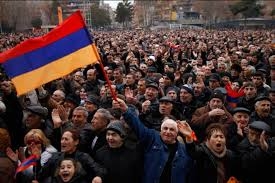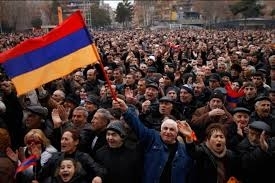Armenia: The Winds of Change, or Armenian Attempt at Velvet Revolution?
From our correspondant in Yerevan
The political situation in Armenia remains tense as opposition rallies and marches all over the country are gathering thousands for the eighth consecutive day despite the repressions and detentions of opposition activists.
These are in fact the biggest demonstrations and protests in the country since March 2008 when the government opened fire against a peaceful demonstration killing at least 10 and wounding hundreds who were demonstrating in support of country’s first president, Levon Ter-Petrosian, who was challenging Sargsyan’s victory in the presidential elections, which were the most criticized by international observers and international community since 1991.
Despite the official statements of Sargsyan prior to the constitutional referendum in 2015, that if a new constitution was approved he would neither try to run for his third presidential term (which was banned by the constitution) nor become a prime-minister, most political experts and opposition leaders were sure that Sargsyan was trying to change the constitution in order to keep the power in his hands after the end of his second and last presidential term in April 2018. Indeed, Sargsyan managed to change the constitution of Armenia, despite the protests and questionable referendum transforming it from a semi-presidential to parliamentary republic and guaranteeing super constitutional rights and powers for the Prime Minister.
After the questioned and hard-criticized parliamentary elections in April 2017, Sargyan's ruling republican party managed to get a parliamentary majority which would allow him to hold on to power after his presidential term was up, but as Prime Minister, without limited terms.
The protests started at the beginning of April when Sargsyan in a public speech said that he had changed his mind about not becoming a PM, and if his party insists, he will not avoid of the responsibility and will take the most important post of the country in coming the next Prime Minister.
The speed of developments as well as the growing number of demonstrators were a surprise not only for Sargsyan’s government but also for absolute majority of political experts and even opposition leaders, during the first demonstrations the number of demonstrators were not bigger than 50 which added Sargsyans supporters self-confidence that no serious obstacle will make problems for Sargsyan to become prime-minister of the country, however the rally of April 13 was a surprise for many, gathering few thousands in Freedom Square which allowed the opposition to announce a sit-in non-stop demonstration in capital’s central square of France.
The demonstrations and rallies escalated on April 16 when the opposition declared the start of the civil disobedience protests and actions, following Pashinyan's call for all major streets and avenues of Yerevan to be blocked by the opponents of Sargsyan's government. The vast majority of students announced they are stopping their lessons and joining the protests with the demand of a change of power in the country. A clash between the police and peaceful demonstrators changed nothing as the demonstrations are networked and autonomic, without centralization, which is the tactic of Nikol Pashinyan.
Armenia has not witnessed this kind of decentralized and networked protest movement for many years. The vast majority of the demonstrators are young students or middle class citizens who despite their financial stability do not want to be transformed into a traditional post-soviet state under the permanent rule of one person; they want change in the government, and bigger change in the country.
Demonstrators widely use social media and various technologies to deliver the messages of the opposition, which the government tries to limit by banning the use of facebook, youtube and Radio Liberty’s website in all administrative buildings. The situation is changingvery fast, driving more and more people to the streets, whose main slogan is “Make a step and reject Serzh”.
On April 17, during his speech in a rally in Yerevan’s Republic Square in front of the Government building, Pashinyan announced that the demonstrations are stepping into a new phase, and the plan of the opposition is to organize a velvet, non-violent revolution. He also announced that he and his supporters will start forming a Revolution Committee to coordinate the Velvet Revolution process.
From April 18, police started detaining hundreds of political activists and supporters of the opposition. According to human rights defenders and the lawyers of the detained or arrested activists, the basic rights of the activists are being seriously violated from the moment of detention to the further procedures at the police departments.
Human rights defenders and journalists following the human rights violations in the streets of Yerevan and police departments also get attacked by unknown people suspected as plain-clothes policemen.
Journalist of the Union of Informed Citizen Media, Tirayr Muradyan, who was hospitalized yesterday with serious head trauma, says he was violently attacked by unknown people in the presence of the policeman and the policemen didn’t even attempt to protect him.
However, despite the repressions, detentions and activists, the protests do not stop increasing in size and are gathering bigger and bigger crowds not only in Yerevan but also in other cities of Armenia who take to the central streets and squares of the country each day from the early morning till midnight.
Due to the pressure of demonstrations, yesterday during the meeting of the government, Sargsyan officially annulled the decision accepted by former PM Karen Karapetian, to give him ownership of the number 1 house in Armenia, the residence of all Armenian leaders since the Soviet times. On April 17, during the parliamentary meeting, the question arose as to whether or not it was right to take into private ownership a house which had belonged to the leaders of the country from communist times to independence. Sargsyan announced that he has a right to have an official residence like the previous Armenian Presidents who got ownership of other houses, not governmental or historical ones.
The opposition movement to Sargsyan has gained a lot of support from the Armenian Diaspora, which representatives following the steps of their Armenian compatriots who are blocking the streets and administrative building in Armenia, by surrounding and blocking the diplomatic and consular buildings of Armenia in the United States, Europe, and even in Moscow.
The United States, Russia and the EU have already officially addressed the Government of Armenia and have told demonstrators that they hope the rallies and demonstrations will keep their peaceful character and everything will be keep in line with the laws and the constitution of Armenia.
By Karen Tovmasyan












